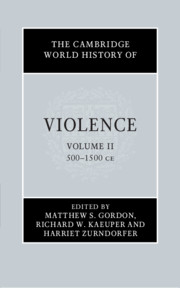Book contents
- The Cambridge World History of Violence
- The Cambridge History of Violence
- The Cambridge World History of Violence
- Copyright page
- Contents
- Figures and Table
- Contributors to Volume II
- Introduction to Volume II
- Part I Beyond Warfare: Armies, Tribes and Lords
- Part II The Violence of Governments and Rulers
- Part III Social, Interpersonal and Collective Violence
- Part IV Religious, Sacred and Ritualised Violence
- 17 Religion and Violence in China
- 18 Buddhism and Violence in Premodern Japan
- 19 Human Sacrifice and Ritualised Violence in the Americas before the European Conquest
- 20 ‘Not Cruelty but Piety’
- 21 Chivalric Violence
- 22 Jihad in Islamic Thought
- 23 Christian Violence against Heretics, Jews and Muslims
- 24 ‘Fighting for Peace’
- Part V Depictions of Violence
- Index
- References
17 - Religion and Violence in China
from Part IV - Religious, Sacred and Ritualised Violence
Published online by Cambridge University Press: 13 March 2020
- The Cambridge World History of Violence
- The Cambridge History of Violence
- The Cambridge World History of Violence
- Copyright page
- Contents
- Figures and Table
- Contributors to Volume II
- Introduction to Volume II
- Part I Beyond Warfare: Armies, Tribes and Lords
- Part II The Violence of Governments and Rulers
- Part III Social, Interpersonal and Collective Violence
- Part IV Religious, Sacred and Ritualised Violence
- 17 Religion and Violence in China
- 18 Buddhism and Violence in Premodern Japan
- 19 Human Sacrifice and Ritualised Violence in the Americas before the European Conquest
- 20 ‘Not Cruelty but Piety’
- 21 Chivalric Violence
- 22 Jihad in Islamic Thought
- 23 Christian Violence against Heretics, Jews and Muslims
- 24 ‘Fighting for Peace’
- Part V Depictions of Violence
- Index
- References
Summary
By the middle of the first millennium CE in China the notion that the unseen world, while capable of offering respite from the perils of our world, was itself full of danger was shared both by Daoists drawing on earlier local ways of thinking and by Buddhists who incorporated beliefs originating in South Asia. In reality the this-worldly economic success of the monastic establishments of the latter tradition attracted occasional episodes of forced, often violent laicization at the hands of the state, while eschatological ideas drawn from both traditions nourished for some alternative visions of the future that also triggered violent clashes with the authorities. Exhortations to devoutness meanwhile could spur self-inflicted violence, whereas the summoning of demons to injure others was recognised and forbidden in the legal code. As our sources become more plentiful from the end of the first millennium onward, we learn more of the sometimes sanguinary content of popular religious eschatology, while it also becomes clear that the imagery of violence was commonplace in a wide range of religious contexts and that in situations such as those of foreign invasion or political collapse fear of demons could prompt unrestrained and merciless violence against outsiders.
- Type
- Chapter
- Information
- The Cambridge World History of Violence , pp. 349 - 367Publisher: Cambridge University PressPrint publication year: 2020



